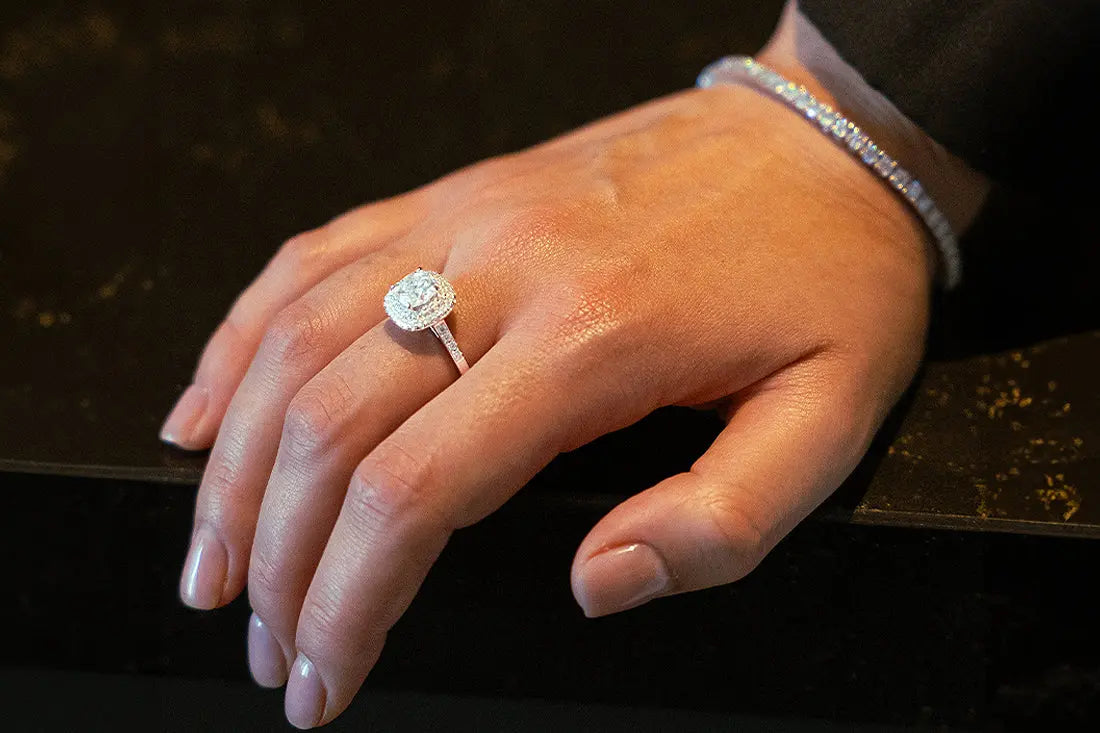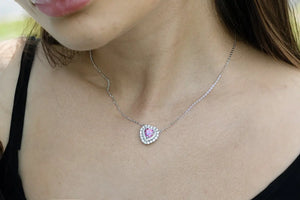Moissanite ring or a diamond one? If you are confused between these two, Here is a must-read for you! This article covers full details about Moissanite Vs. Diamonds to help you make the right choice. Explore a better gemstone to get the best value for your money.
Before we start with Moissanite Vs diamond, let us give you a quick introduction to both.
Moissanite:
Moissanite is a gemstone that appears precisely the same as diamonds. It is hard to find the difference between these two visually. But, their composition differs. On the one hand, diamonds are made of carbon obtained from mining. Moissanite is a silicon carbide generated in labs.
Diamond:
Diamond is a solid form of carbon that is arranged in the form of a crystal. They are the top choice for jewelry and rings from the upper class. The gemstone is known for its brilliance, hardness, and elegance.
Moissanite vs. Diamond: A Quick Comparison
Moissanite vs. Diamond: Cost Comparison:
Moissanite diamonds are lab-created; hence, they cost just about one-tenth of the diamonds. Hence they are a better choice for the people who need a large-carat gemstone but have a limited budget.
Moissanite can be bought for about $400-$600 per carat. On the other hand, a one-carat diamond can be somewhere between $2000-$20,000. So, there is a massive difference in their prices.
Moissanite vs. Diamond: Durability Comparison
Diamonds are known for their long-lasting nature. They are hard and can easily resist any type of wear and tear. On the Mohs hardness scale, diamonds are rated 10 and have the highest ratings.
Moissanite is the second hardest gemstone, only next to the diamonds. Depending on the rankings, moissanite has the second-ranking, 9.25-9.5, and diamonds have 10 out of 10. Moissanite is suitable for daily wear and resistant to scratches.
Moissanite vs. Diamond: Visual Appeal
Moissanite gems look precisely like diamonds. They, indeed, have more brilliance than diamonds. Here is a quick comparison between the two.
Brilliance:
One striking difference between Moissanite and diamond is their brilliance. Moissanite has more brilliance than diamonds. The gemstone has more fire and hence sparkles better than the diamonds. They have a double refractive index compared to diamonds, which leads to more sparkle.
Moreover, when you rotate the moissanite, you will be able to see an entire rainbow, while diamonds just reflect white light.
Colour:
The purest form of diamond is absolutely colourless. Contrary to this, Moissanite has either a greenish or yellowish tinge. Efforts are, however, on to make this stone colorless.
Moissanite Gemstone Shopping Considerations
If you want super elegance and have a limited budget, moissanite will be a better choice, especially for jewellery. There are certain important factors to consider when you want to shop for moissanite. Take care of the following:
-
Understand the 4Cs While Shopping: Moissanite, or in fact, any other gemstone, is graded on the 4Cs, which are cut, clarity, color, and carat. Choose the one with a high grade and the highest level of brilliance.
-
Choose Just the Right Cut: How the gemstone has been cut affects how it sparkles. Some of the popular cuts include cushion, round brilliant, and princess. Choose a cut wisely, suiting your preference.
-
Decide the Right Colour: Moissanite is available in a vast range of colors. (D-F) are for the colorless ones, whereas (G-H) are for near-colorless ones. The colorless ones are more similar to the diamonds.
-
Look for Trusted Certification: Make sure that the moissanite has a trusted certification from sources like IGI and GIA for finding the best quality and ensuring authenticity.
-
Reputation of Vendors: It is good to find out the reputation of the jeweller before shopping. Make very sure to read the reviews, their return policy, discounts, etc.
-
Consider the Budget: Moissanite is the best choice for the budget-friendly. This is so because it costs only a fraction and sparkles brighter than the diamond. It is actually a replica of a diamond.
Also, it should be noted that some moissanite is treated to improve its clarity and color. So, when you need to shop you should verify whether the stone has previously undergone any type of enhancement.
Comparison Table: Moissanite vs. Diamond
|
Attribute |
Moissanite |
Diamond |
|
Color |
Available in near-colorless and colorless options, but often has a slight warm hue |
Graded D-Z, with D-F considered colorless. Pure colorless diamonds are rare and highly valuable |
|
Durability |
Mohs scale rating: 9.25. Resistant to scratches and suitable for daily wear |
Mohs scale rating: 10. The hardest natural substance, highly resistant to wear |
|
Brilliance |
High refractive index (2.65–2.69), creating intense fire and rainbow-like sparkle |
Lower refractive index (2.42) with classic white-light sparkle, often perceived as more subtle |
|
Price |
Roughly 10-20% the cost of a similar-sized diamond, depending on quality and size |
Higher cost, influenced by the 4 Cs (carat, cut, color, clarity); often considered a luxury item |
|
Sourcing |
Lab-created, with minimal environmental impact. Ethical choice for eco-conscious buyers |
Often mined, with ongoing ethical concerns despite sourcing certifications |
|
Chemical Composition |
Silicon carbide (SiC), created synthetically for jewelry |
Pure carbon (C), formed under intense heat and pressure within the Earth |
|
Thermal Conductivity |
High, but different from diamond, which affects some diamond testers’ ability to detect it |
Extremely high, which is why it conducts heat better than most stones, often tested for authenticity |
|
Environmental Impact |
Low, Because free from mining’s ecological impact |
Mining can cause significant environmental degradation; efforts to improve sustainable sourcing |
|
Investment Value |
Holds intrinsic beauty and quality but lacks high resale or investment value |
Often retains some resale value, depending on quality; valued for tradition and perceived as an asset |
|
Hardness |
9.25 on Mohs scale, very durable but slightly softer than diamond |
10 on Mohs scale, the hardest natural material, highly scratch-resistant |
|
Fire Dispersion |
0.104, creating a noticeable rainbow effect in sunlight |
0.044, which results in a more subdued and classic sparkle |
|
Certification |
Typically certified by independent labs for origin and quality |
Certified by GIA, IGI, and other gemological institutions, grading based on cut, color, clarity, and carat |
|
Appearance under Magnification |
Double refraction may be noticeable, giving it a unique look |
Single refraction, which results in a consistent, classic appearance under magnification |
|
Ideal for |
Buyers looking for an affordable, eco-friendly alternative with unique brilliance |
Those seeking a classic gemstone with investment potential and timeless appeal |
|
Resale Value |
Low, as moissanite is not traditionally viewed as an investment |
Can retain resale value, particularly in high-quality stones with favorable 4 Cs |
|
Popularity in UK |
Growing in popularity among eco-conscious and budget-friendly buyers |
Remains the top choice for engagement rings due to tradition and perceived prestige |
FAQs
Here are a few commonly asked questions about Moissanite that help you make a wiser buying decision.
1. Is moissanite as durable as a diamond?
Yes, It has a hardness of 9.25 on the Mohs scale, which makes it suitable for daily wear and tear without the fear of getting scratched.
2. Does moissanite sparkle like a diamond?
Moissanite sparkles brighter than diamonds as they have a higher refractive index. Its rainbow-like brilliance is loved by the people.
3. Is moissanite a synthetic stone?
Yes, it is. It is created in labs.
4. How does moissanite compare in price to diamonds?
Moissanite costs far less. It costs 80-90% less and has a smaller size and appearance.
5. Can moissanite be resized or reset?
Yes, Moissanite can be reset or resized, but you need to make sure it is done by a skilled person only.
6. Does moissanite lose its sparkle over time?
No, moissanite retains its brilliance and sparkle for a very long time when cleaned and maintained carefully.
7. What’s the difference between moissanite and cubic zirconia?
Moissanite is much harder and much more durable. It has a very high level of brilliance when compared to Cubic Zirconia.
8. Is moissanite hypoallergenic?
Yes, it is. So, if you have sensitive skin, it will be an excellent choice for you.
Moissanite vs. Diamond, there are some clear-cut differences. Even though they look the same, moissanite is chosen by budget-conscious people who need more sparkle and larger carats without shelling out more money. Are you the one?



